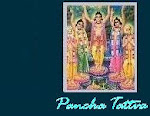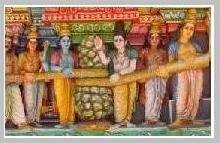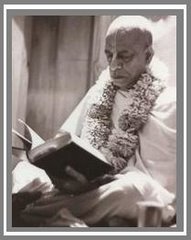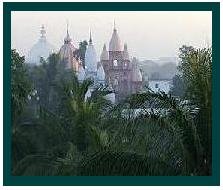The following is from the book Easy journey to other planets
by A.C Bhaktivedanta Swami
The
most widely recognized scriptures in the world are the Vedas. The Vedas have
been divided into four parts: Sāma,
Yajur, Ṛg and Atharva. The
subject matter of the Vedas is
very difficult for a man of ordinary understanding. For elucidation, the four Vedas are
explained in the historical epic called the Mahābhārata and
in eighteen Purāṇas.The Rāmāyaṇa is
also a historical epic which contains all the necessary information from theVedas. So
the four Vedas, the
original Rāmāyaṇa by
Vālmīki, the Mahābhārata and
the Purāṇas are
classified as Vedic literatures. The Upaniṣads are
parts of the four Vedas, and
the Vedānta-sūtras represent
the cream of the Vedas. To
summarize all these Vedic literatures, the Bhagavad-gītā is
accepted as the essence of all Upaniṣads and
the preliminary explanation of the Vedānta-sūtras. One
may then conclude that from the Bhagavad-gītā alone
one can have the essence of the Vedas, for
it is spoken by Lord Śrī Kṛṣṇa, the Supreme Personality of Godhead, who descends
upon this material world from the anti-material world in order to give complete
information of the superior form of energy. The
superior form of energy of the Personality of Godhead is described in the Bhagavad-gītā as parā
prakṛti. The scientists have recently discovered that there are two forms of
perishable matter, but the Bhagavad-gītā describes
most perfectly the concept of matter and antimatter in terms of two forms of
energy. Matter is an energy which creates the material world, and the same
energy, in its superior form, also creates the anti-material (transcendental)
world. The living entities belong to the category of superior energy. The
inferior energy, or material energy, is called aparā
prakṛti. In the Bhagavad-gītā the
creative energy is thus presented in two forms, namely aparā and parā
prakṛti.
The
superior form of energy of the Personality of Godhead is described in the Bhagavad-gītā as parā
prakṛti. The scientists have recently discovered that there are two forms of
perishable matter, but the Bhagavad-gītā describes
most perfectly the concept of matter and antimatter in terms of two forms of
energy. Matter is an energy which creates the material world, and the same
energy, in its superior form, also creates the anti-material (transcendental)
world. The living entities belong to the category of superior energy. The
inferior energy, or material energy, is called aparā
prakṛti. In the Bhagavad-gītā the
creative energy is thus presented in two forms, namely aparā and parā
prakṛti.
Matter
itself has no creative power. When it is manipulated by the living energy,
material things are produced. Matter in its crude form is therefore the latent
energy of the Supreme Being. Whenever we think of energy, it is natural that we
think of the source of energy. For example, when we think of electrical energy,
we simultaneously think of the powerhouse where it is generated. Energy is not
self-sufficient. It is under the control of a superior living being. For
example, fire is the source of two other energies, namely light and heat. Light
and heat have no independent existence outside of fire. Similarly, the inferior
and superior energies are derived from a source, which one may call by any name.
That source of energy must be a living
being with full sense of everything. That supreme living being is the
Personality of Godhead, Śrī Kṛṣṇa, or the all-attractive living being.


















